Plan and manage schedule
Enablers
- Estimate project tasks (milestones, dependencies, story points). (ECO 2.6.1)
- Utilize benchmarks and historical data. (ECO 2.6.2)
- Prepare schedule based on methodology. (ECO 2.6.3)
- Measure ongoing progress based on methodology. (ECO 2.6.4)
- Modify schedule, as needed, based on methodology. (ECO 2.6.5)
- Coordinate with other projects and other operations. (ECO 2.6.6)
Deliverables, and Tools
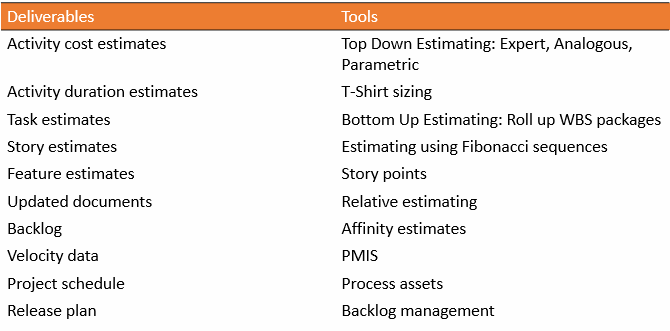
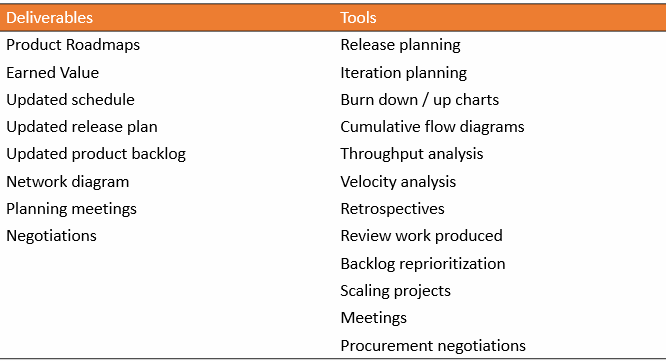
Project Schedule
The project schedule * is an output of a schedule model that presents linked activities with planned dates, durations, milestones, and resources.
- Includes starting and finishing activities on specific dates and in a certain sequence.
- Specifies planned dates for meeting project milestones.
- Coordinates activities to form a master plan in order complete the project objectives on time.
- Tracks schedule performance and keeps upper management and project stakeholders informed about the project’s status.
Benchmarks and Historical Data
- Benchmarking * in the context of scheduling is the comparison of a project schedule to a schedule for a similar product or service produced elsewhere.
- Benchmarks can be useful in the initial stage of scheduling, to help assess the feasibility of a project.
- Historical data, on the other hand, can come from other projects completed within an organization for which detailed information is available.
- Historical data provides a good “starting point” for how long something should take, prior to detailed analysis.
Schedule Management Plan
A schedule management plan * is a component of the project or program management plan that establishes the criteria and the activities for developing, monitoring, and controlling the schedule.
- Describes how activities will be defined and progressively elaborated.
- Identifies a scheduling method and scheduling tool that will be used for a project.
- Determines the format of the schedule.
- Establishes criteria for developing, monitoring, and controlling the project schedule.
Components of the Schedule Management Plan:
- Project schedule model used
- Accuracy of activity duration estimates
- Units of measure to be used
- Organizational procedures links used with the WBS
- Control thresholds to be used for monitoring schedule performance
- Rules of performance measurements to be used
- Reporting formats to be used
- Process descriptions to explain how schedule management processes are to be documented throughout the project.
Schedule Management Considerations for Agile/Adaptive Environments
Total project timeline may be developed
Individual activities scheduled iteratively
Two main iterative approaches:
- Iterative scheduling with backlog
- On-demand scheduling
Processes involved in Project Schedule Management include:
- Plan Schedule Management
- Define Activities
- Sequence Activities
- Estimate Activity Durations
- Develop Schedule
- Control Schedule
Iterative Scheduling with a Backlog
- Progressive elaboration (rolling wave) techniques to develop and schedule activities
- Uses a specific time window, often two weeks
- Requirements defined in user stories
- Stories prioritized
- Selected based on priority and time box
- Remaining stories added to backlog
- Constructed later based on their priority
- Delivers business value early and incrementally
- Allows changes/adaptations during entire project
- Does not work well when there are complex dependency relationships
On-Demand Scheduling
- Does not use traditional schedules
- Team members "pull" work from a queue as their availability allows
- Based on Kanban and Lean methodologies
- Provides incremental business value
- Leveling out the work of the team members
- Works best when work can be divided into relatively equal amounts
- Does not work well with activities that have complex dependency relationships
Guidelines to Develop a Schedule Management Plan
- Review the project management plan for information to develop the schedule
- Review the project charter for a summary, high-level milestone schedule.
- Review the EEFs
- Review the OPAs
- Use tools and techniques such as expert judgment and historical information
- Use meetings to develop the schedule management plan
- Document the schedule management plan for the project
Project Activities
An activity * is a distinct, scheduled portion of work performed during the course of a project.
Activities lay the foundation for estimating, scheduling, executing, monitoring, and controlling the project work. The characteristics of an activity are:
- It has an expected duration. (How long will it take?)
- It consumes budget or human resources. (Who will do the work?)
- It has a performance-based name. (What is being accomplished?)
Features
- Used to group related functionality together that delivers business value.
- Activities and efforts—including work such as documentation, bug fixes, testing, quality/defect repairs.
- Deliver capability that can be estimated, tracked, and managed as a set.
- Scheduling aligned to features ensures associated work is coordinated.
- Estimating features gives a view of when blocks of functionality can be released to the business and end users.
- Progress can be measured based on the features accepted by the business compared to the features remaining.
Milestones
A milestone * is a significant point or event in a project, program, or portfolio.
Guidelines for Estimating Project Activities
- Review the schedule management plan
- Review the scope baseline for the WBS, deliverables, assumptions and constraints
- Review the EEFs
- Review the OPAs
- Analyze and decompose each work package of the WBS into activities (if desired) that will be required to produce the deliverable
- Consult subject matter experts (SMEs) about unfamiliar material
- Evaluate all constraints and assumptions for their possible impact on activity definition
- Once you have decomposed each work package into activities, evaluate your activity list
Activity Dependency
- An activity dependency is a logical relationship that exists between two project activities.
- The relationship indicates whether the start of an activity is contingent upon an event or input from outside the activity.
- Activity dependencies determine the precedence relationships.
Types of Activity Dependencies
- A mandatory dependency * is a relationship that is contractually required or inherent in the nature of the work.
- A discretionary dependency * is a relationship that is established based on knowledge of best practices within a particular application area or an aspect of the project where a specific sequence is desired.
- An external dependency * is a relationship between project activities and non-project activities.
- An internal dependency is a dependency between project activities and is usually under the project's control.
Precedence Relationships
A precedence relationship * is a logical dependency used in the precedence diagramming methods (PDMs) *.
- In other words, the precedence relationship exists between activities that describe the sequence in which the activities should be carried out.
- Each activity has two open points: start and finish.
- Precedence relationships consider appropriate logic while connecting these points.
- Precedence indicates which of two activities drives the relationship (the predecessor activity) and which is driven by it (the successor activity).
Types of Precedence Relationships
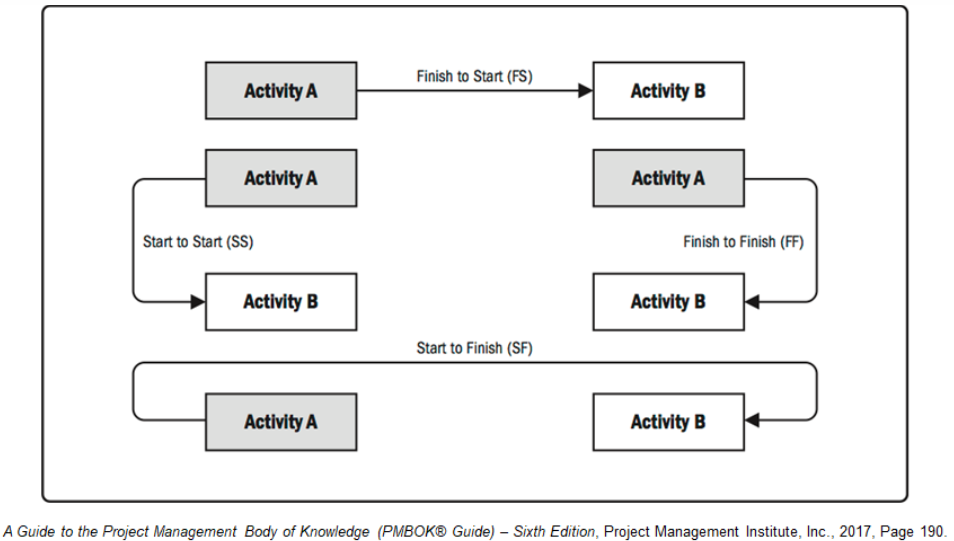
Guidelines to Sequence Project Activities
- Review the schedule management plan for information on the scheduling method and tool, and information on how activities may be sequenced.
- Determine the dependencies among project activities by using your activity list and product descriptions.
- Identify predecessor and successor activities by reviewing the activity attributes for each activity, including predecessor or successor relationships.
- Review the milestone list for the dates for specific schedule milestone events.
- Review the project scope statement for the scope description, deliverables, constraints, and assumptions that may affect activity sequencing.
- Review the EEFs such as government or industry standards, Project Management Information System, scheduling tool, and work authorization systems.
- Review the OPAs such as activity planning policies, procedures, guidelines, and templates.
- Use tools and techniques such as Precedence Diagramming Method (PDM), dependency determination, and leads * and lags * to develop the project schedule network diagram.
- Document the project schedule network diagram and update any project documents as needed.
Activity Duration Estimates
- Activity duration estimates * are the quantitative assessments of the likely number of time periods that are required to complete an activity.
- Elapsed time is the actual calendar time required for an activity's completion.
- Effort * is the number of labor units required to complete a scheduled activity or WBS component, often expressed in hours, days, or weeks. Contrast with duration.
Guidelines to Estimate Activity Durations
- Involve the work package owners or others who are familiar with the work of the activity
- Consult lessons learned and historical information
- Review the schedule management plan
- Determine how you want to quantify the work that needs to be done
- Consider resource requirements and capabilities
- Review the resource requirements for each activity
- Check the resource calendars for when resources are available
- Consider interactions with other projects or operations
- Review the project scope statement for assumptions and constraints
- Review the risk register to consider any risks that may impact resource estimation
- Review the resource breakdown structure of resources listed by category and type
- Use tools and techniques
- Document the activity duration estimates
Schedule Presentation Formats
The project schedule can be presented in different formats, depending on the circumstances. Three commonly used schedule formats are:
- Gantt chart
- Milestone chart
- Project schedule network diagram with dates
Gantt Chart
Gantt chart * is a bar chart * of schedule information where activities are listed on the vertical axis, dates are shown on the horizontal axis, and the activity durations are shown as horizontal bars placed according to start and finish dates.
- Shows start and end dates, duration, and order.
- Shows precedence relationships.
- Shows percentage completion and actual progress.
- Used to present project status to the project team and management.
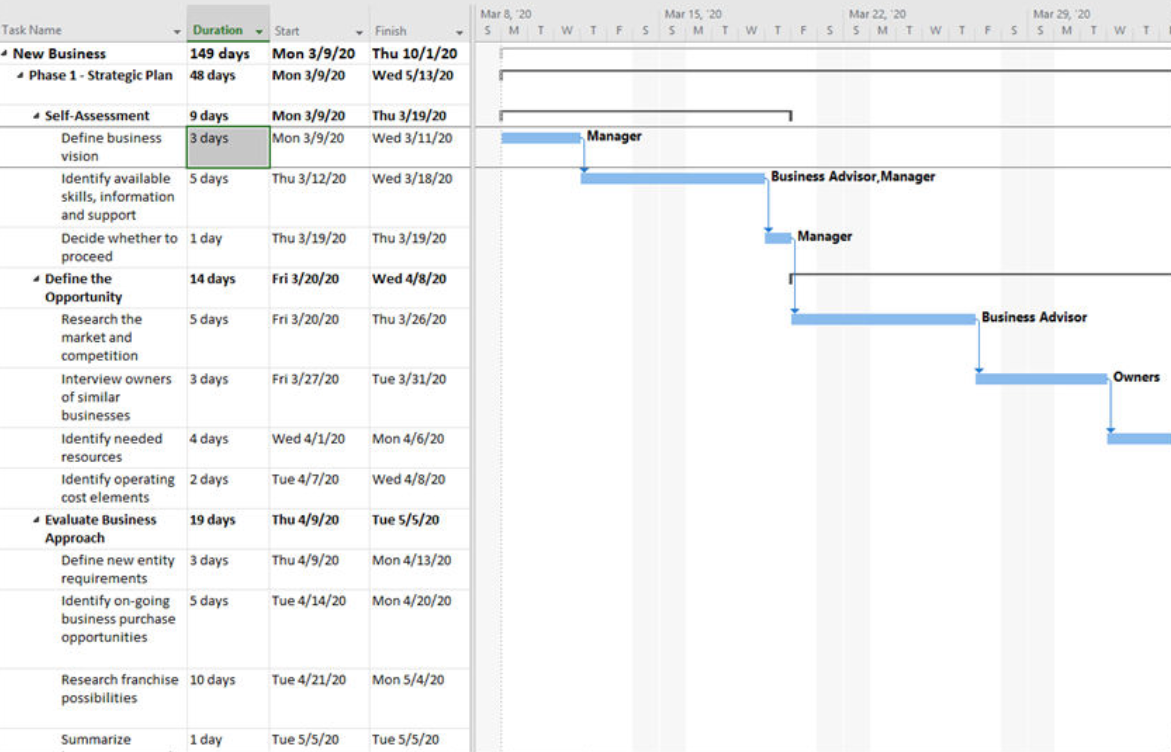
Milestone Chart
A milestone chart provides a summary level view of a project's schedule in terms of its milestones.
- Provides the summary level review of a project’s milestones.
- Uses icons or symbols.
- Useful of upper management, who are not interested in the details.
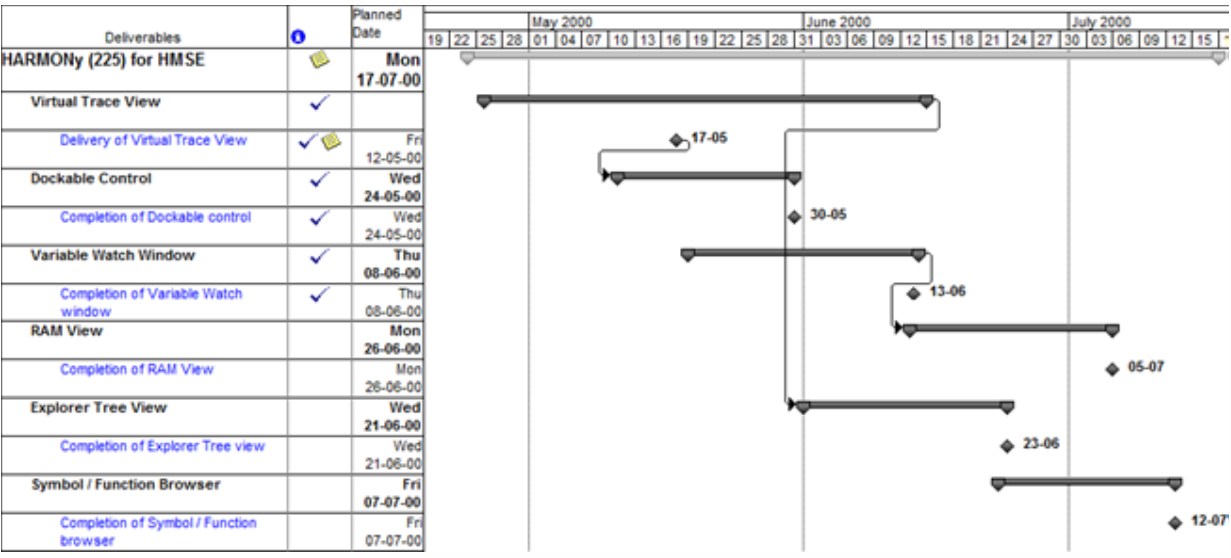
Project Schedule Network Diagram with Dates
Assigns start and finish dates to activities.
Communicates the project status in terms of activity precedence relationship.
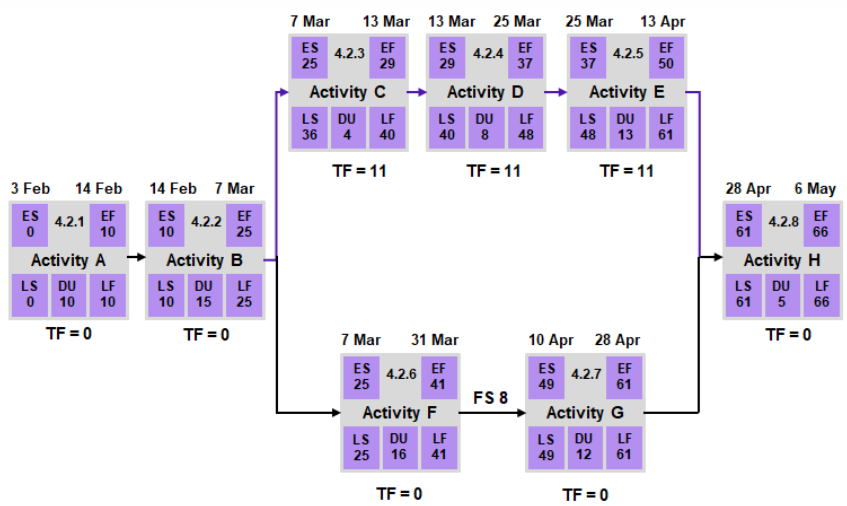
Critical Path
The critical path * is the sequence of activities that represents the longest path through a project, which determines the shortest possible duration.
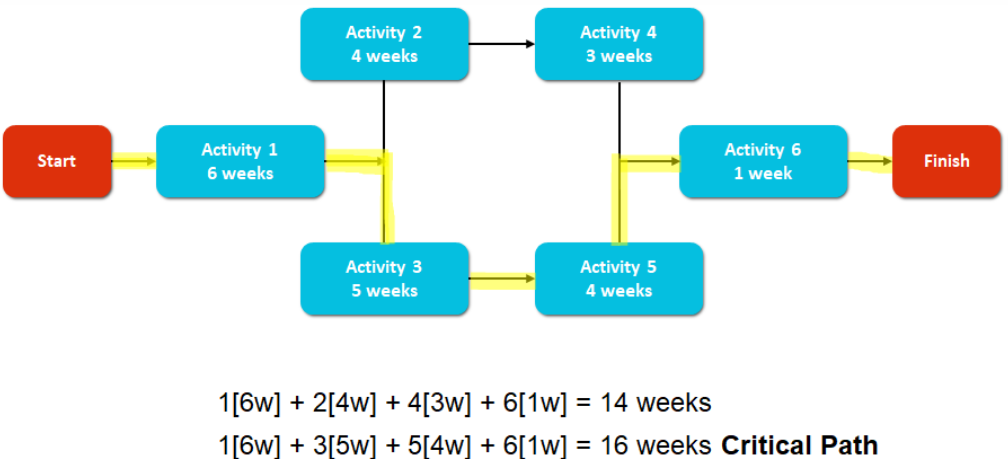
Critical Path Activities
A critical path activity * is any activity on the critical path in a project schedule.
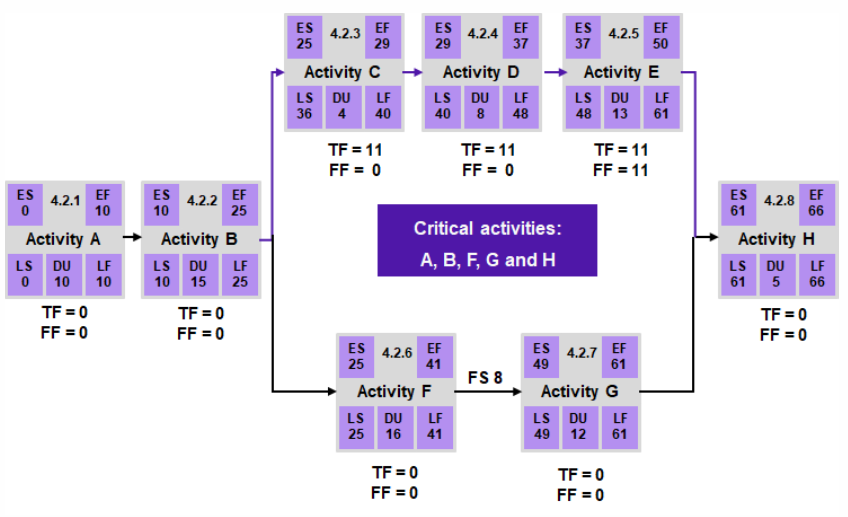
Float
Float * is also called slack. The amount of time an activity can be delayed from its ES without delaying the project finish date or the consecutive activities

Total Float
- Total float * is the amount of time that a schedule activity can be delayed or extended from its early start date without delaying the project finish date or violating a schedule constraint.
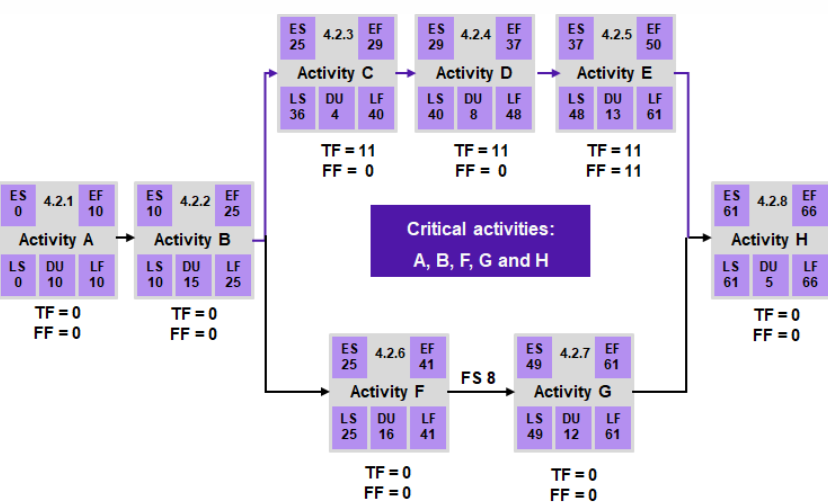
Free Float
Free float * is the amount of time that a schedule activity can be delayed without delaying the early start date of any successor or violating a schedule constraint.
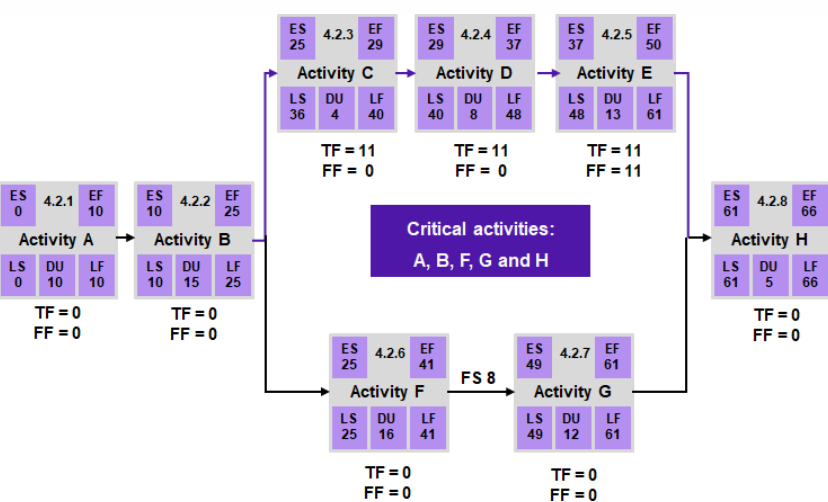
Agile Release Planning
Agile release planning is a product management method where you plan incremental releases of a product.
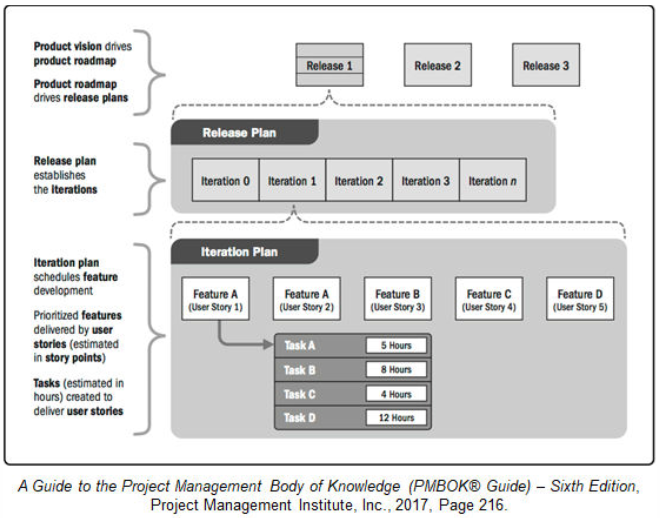
Ongoing Progress Based on Methodology
Measuring the project’s progress with respect to the schedule consists of monitoring the status of:
- The project to update the project schedule
- Managing changes to the schedule baseline
In an agile approach is used to manage the project, progress can be evaluated with the following steps:
- Compare the total amount of work delivered and accepted with the estimate of the work to be completed for the current time period.
- Review the completed work in the regular Sprint demos.
- Conduct scheduled reviews to record lessons learned (also known as retrospectives) for correcting and improving processes.
- Determine the rate at which deliverables are produced, validated, and accepted in the given time per iteration
Coordination with Other Projects
- If the project is part of a program or a portfolio, the schedule status of the project should be evaluated for any effect it has on the other components of the program * or portfolio *.
- In some situations, a delay (or acceleration) of a project may not impact other projects.
- However, if the delay or acceleration is caused by activities on the project’s critical path and that project is critical to the schedule of other projects, the overall effect can be significant.